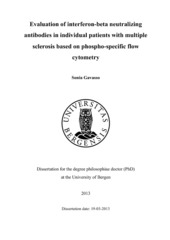| dc.contributor.author | Gavasso, Sonia | en_US |
| dc.date.accessioned | 2013-04-18T08:42:58Z | |
| dc.date.available | 2013-04-18T08:42:58Z | |
| dc.date.issued | 2013-03-19 | eng |
| dc.identifier.isbn | 978-82-308-2255-5 | en_US |
| dc.identifier.uri | https://hdl.handle.net/1956/6528 | |
| dc.description.abstract | Background: Recombinant human interferon-beta (IFN-β) is the most frequently used drug for treating relapsing-remitting multiple sclerosis (RRMS), a demyelinating disease of the central nervous system. It modulates the autoimmune state of patients by systemically affecting immune system functions. The treatment slows disease progression only in a subset of patients and treatment efficacy can be negatively affected if the patient produces neutralizing antibodies (NAb) to IFN-β. NAb in sera are quantified using in vitro bioassays; however, these assays do not reveal the immunogenic state of the patient and are not predictive NAb outcome. Objective: Patient specific NAb assessment based on drug mechanism in primary cells from patients. Method: A whole cell flow cytometry-based technique was developed to quantify the activation of the IFN-β signaling pathway by measuring the phosphorylation of signal transduction and activation of transcription family (Stat) molecules in primary immune cells and assess NAbs effects in individual patients. Peripheral blood mononuclear cells (PBMCs) and whole blood from patients with NAb were restimulated ex vivo with a serial dilution of IFN-β and levels of phosphorylation of Stat 1/3/4/5/6 transcription factors were quantified. To assess in vivo implications of NAb in an individual patient whole blood was collected before and after IFN-β injection, lysed, fixed, and analyzed for Stats activation with phospho-specific flow cytometry. RNA extracted from whole blood at the same time points was used to measure pathway specific gene expression changes in immune cells and sera was used to quantify IFN-β and NAb levels in blood after IFN-β injection. Results: Ex vivo re-stimulation of PBMCs revealed that Stat signaling patterns were modulated in treated NAb-negative patients and inhibited in all treated NAb-positive patients independently of NAb titers. Similar results were obtained when whole blood, rather than PBMCs, was re-stimulated ex vivo. In vivo results confirmed the inhibitory and modulatory effects of NAb on the Jak/Stat signaling pathway as assessed directly after INF-β administration. The Stat proteins affected by NAbs in PBMCs ex vivo were also responsible for much of the variation caused by NAbs in vivo after IFN-β administration. Levels of pStat1, of all Stat proteins, were highly correlated with NAb in both cases. Conclusion: Immunogenic effects altered the response in primary cells even at low NAb levels, suggesting that results from cell line-based immunogenicity testing are not correlated with the immunogenic response in many patients. Based on the IFN-β responsiveness of primary cells three fundamental issues are addressed: 1. the mechanism of action of IFN-β, 2. the immunogenic effect of NAbs in individual patients, 3. underlying disease mechanisms. | en_US |
| dc.language.iso | eng | eng |
| dc.publisher | The University of Bergen | eng |
| dc.relation.haspart | Paper I: Gavasso, S., Myhr, K. M. & Vedeler, C. (2006) Multiplexed phosphoprotein analysis in immune cells. Acta Neurologica Scandinavica 113(183): 58–60, 2006. Full text not available in BORA due to publisher restrictions. The article is available at: <a href="http://onlinelibrary.wiley.com/doi/10.1111/j.1600-0404.2006.00618.x/pdf" target="blank"> http://onlinelibrary.wiley.com/doi/10.1111/j.1600-0404.2006.00618.x/pdf</a> | en_US |
| dc.relation.haspart | Paper II: Gavasso, S. (2009) Flow cytometry and cell activation. Methods in Molecular Biology 514: 35-46, 2009. Full text not available in BORA due to publisher restrictions. The article is available at: <a href="http://dx.doi.org/10.1007/978-1-60327-527-9_4" target="blank"> http://dx.doi.org/10.1007/978-1-60327-527-9_4</a> | en_US |
| dc.relation.haspart | Paper III: Gavasso, S., Gjertsen, B., Anderssen, E., Myhr, K. & Vedeler, C. (2012) Immuno genic effects of recombinant interferon-beta therapy disrupt the JAK/STAT pathway in primary immune cells from patients with multiple sclerosis. Multiple Sclerosis 18(8): 1116-1124, August 2012. Full text not available in BORA due to publisher restrictions. The article is available at: <a href="http://dx.doi.org/10.1177/1352458511434066" target="blank"> http://dx.doi.org/10.1177/1352458511434066</a> | en_US |
| dc.relation.haspart | Paper IV: Gavasso, S., Mosleth, E., Marøy, T., Jørgensen, K., Nakkestad, HL., Gjertsen, B. T., Myhr, K M. & Vedeler, C. A. Deficient phosphorylation of Stat1 in leukocytes identifies neutralizing antibodies in multiple sclerosis patients treated with interfero-beta. Full text not available in BORA. | en_US |
| dc.title | Evaluation of interferon-beta neutralizing antibodies in individual patients with multiple sclerosis based on phospho-specific flow cytometry | en_US |
| dc.type | Doctoral thesis | |
| dc.rights.holder | Copyright the author. All rights reserved | |

